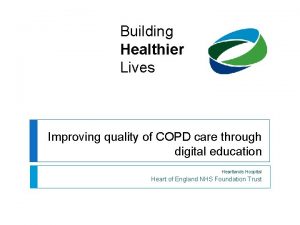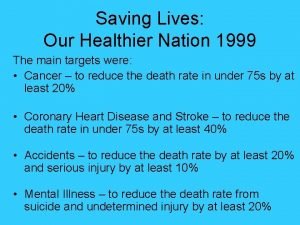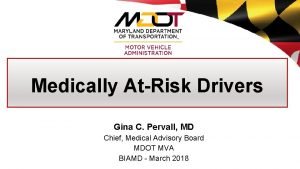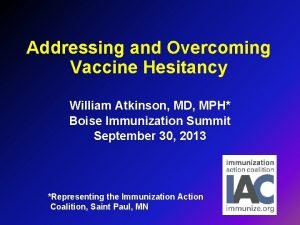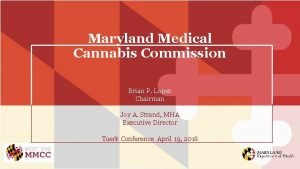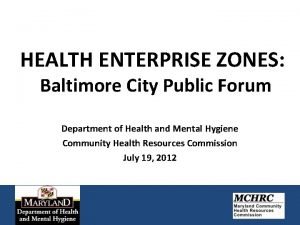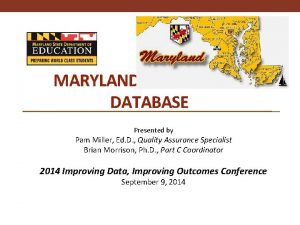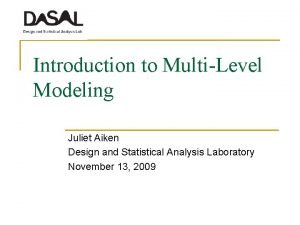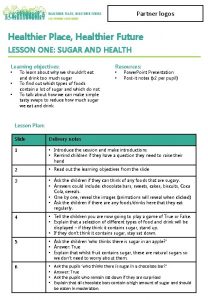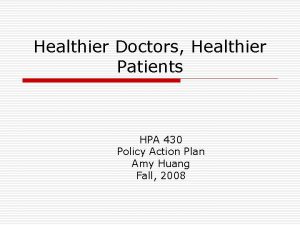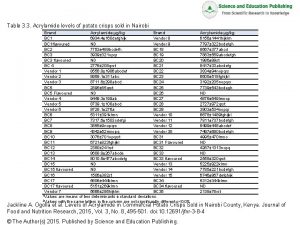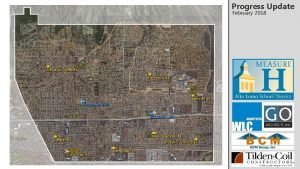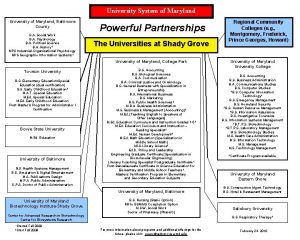CRISPs Progress in Supporting a Healthier Maryland Update




















- Slides: 20

CRISP’s Progress in Supporting a Healthier Maryland Update to CMSA of the Chesapeake, April 28 th, 2017 David Finney, Chief of Staff 1

Overview 2

CRISP Vision, Mission & Principles • Our Vision • To advance health and wellness by deploying health information technology solutions adopted through cooperation and collaboration. • Our Mission • We will enable and support the healthcare community of Maryland our region to appropriately and securely share data in order to facilitate care, reduce costs, and improve health outcomes. Our Guiding Principles 1. Begin with a manageable scope and remain incremental. 2. Create opportunities to cooperate even while participating healthcare organizations still compete in other ways. 3. Affirm that competition and marketmechanisms spur innovation and improvement. 4. Promote and enable consumers’ control over their own health information. 5. Use best practices and standards. 6. Serve our region’s entire healthcare community. 3

4 History of CRISP 2006: CRISP begins at a Spring meeting between John Erickson and the CIOs of Maryland’s three largest hospital systems, asking how to make medical records for seniors available when they visit the hospital. Erickson Retirement Communities assigns part-time staff. 2007: University of Maryland Shore Medical Center at Easton pilots a medication history service in the ED with CRISP 2008: CRISP partners with MHCC to plan an HIE for Maryland, in a process which engages dozens of healthcare stakeholders. MHCC provides a $250 k grant, and the Erickson Foundation contributes another $250 k to expand the work. 2009: CRISP finishes incorporation as a non-profit membership corporation, is named Maryland’s designated statewide HIE (July), is awarded a $10 M HSCRC grant (August), and hires staff (September) 2010: CRISP connects the first provider organizations (September) and wins a $6 M REC grant 2011: Clinicians begin using the Query Portal (February) and every Maryland hospital is connected (December) 2012: CRISP turns on the ENS service (August) and the Board is expanded (December) 2013: CRISP begins sending CRS reports (January), goes live with the MHBE Provider Directory (September), connects the first District of Columbia hospital (November), and turns on PDMP services with Maryland DHMH (December) 2014: Health plans begin accessing records through a new portal (March), and CRISP begins routing CCDAs at hospital discharge (June) 2015: CRS monthly hospital reports grow from 2 to 17, Tableau reporting tool is turned on (March), HSCRC funds the ICN project to support care management (August), and image exchange goes live (December) 2016: In-context Alerts go live (May), first Medicare data reports are released (September), West Virginia’s WVHIN partners with CRISP (October), and CRISP DC is formed (December)

5 “Mature” CRISP Services for Providers 1. Maryland Prescription Drug Monitoring Program • Monitor the prescribing and dispensing of drugs that contain controlled dangerous substances 2. Encounter Notification Service (ENS) • Be notified in real time about patient visits to the hospital 3. Query Portal • Search for your patients’ prior hospital and medication records 4. Direct Secure Messaging • Use secure email instead of fax/phone for referrals and other care coordination

Key Performance Indicator Dashboard 6

Collaboration with DHMH Prescription Drug Monitoring Program (PDMP) Ø PDMP data available to providers and dispensers along side clinical data Ø Close partnership with Behavioral Health Administration to support the continued development of the program and services Ø Maryland Mandatory Registration and Use Ø PDMP data available via In-Context Alerts Ø Interstate Sharing with West Virginia, Connecticut and Arkansas Population Health Reports Ø Geographic mapping for public health officials of hospital encounters, and when married to HSCRC claims data, specific conditions Ø Population health management reports and dashboards at county and zip-code levels available to Local Health Departments 7

Collaboration with DHMH Support of State Medical Examiner and Fatality Review Teams Ø CRISP serves as a source of clinical information in death investigations Ø Overdose Fatality Review Ø Maternal Mortality Review Ø Fetal & Infant Mortality Review Ø Child Fatality Review Ø Provides administrative efficiencies and data in time-sensitive situations Meaningful Use Ø CRISP facilitates public health reporting and attestation for hospitals and providers Ø Routing Eligible Hospital data to DHMH Ø Providing MU Phone and Email Support to Eligible Professionals Ø Working on facilitating case reporting and PDMP as public health reporting options for EP’s Ø Developed a Registration Tool for tracking MU progress Ø Developed a validation tool that incorporates HL 7 and Maryland message requirements 8

Collaboration with DHMH Disease Investigation Ø Public Health Investigators utilize CRISP for Reportable Disease Investigation Ø Demonstrably more efficient and richer data source for hospital-reported conditions than previous methodology Ø HIV Care Reengagement Ø Alert DHMH when HIV positive individuals encounter health system Ø Reconnect individuals to treatment and individuals who never learned status Oz System Ø Newborn alerting, to facilitate mandatory hearing screening Immu. Net Registry Ø DHMH Immu. Net registry data available in CRISP Clinical Query Portal 9

ICN Program 10

ICN Background In 2014, the Maryland Health Services Cost Review Commission (HSCRC), with the support of the Department of Health and Mental Hygiene (DHMH), established a Care Coordination Work Group to offer advice on how hospitals, physicians, and other key stakeholders can work together with government leaders on effective care coordination to support the Maryland All-Payer model. The workgroup led to the creation of the Integrated Care Network Infrastructure or “ICN” project, through which CRISP was charged to establish processes and leverage services for three components critical to modernization effort: • Identification of at-risk patients who could benefit from care coordination or a targeted intervention • Communication—especially at the point of care—of existing patient relationships and connected services • Monitoring the effectiveness of programs and initiatives, especially by measuring their impacts on the bigger total-costof-care 11

“Workstream” Framework Anja Hewitt Mike Banfield 1. Ambulatory Connectivity: We are connecting more practices, physicians, long-term-care facilities, and other health providers to the CRISP network. 2. Routing Data: We are building a data router: including data normalization, patient consent management, patient-provider relationships – for sharing patientlevel data. Ryan Bramble/ Bill Howard 3. Clinical Portal Enhancements: We will enhance the existing Clinical Query Portal with a care profile; a provider directory; information on other known patientprovider relationships; and risk scores. Jon Becker, Ph. D 4. Notification & Alerting: We will create new alerting tools so that notifications happen within the context of a provider’s existing workflow. Users are notified when a patient is in care management. Jerry Reardon, Ph. D 5. Reporting & Analytics: We will expand existing CRISP reporting services and make them available to a wider audience of care managers. The new services include tools for risk stratification and population health management. Michelle Rubin 6. Basic Care Management Software: We will support care management software platforms – through data feeds, reports and a basic shared care management tool available to organizations without their own. David Finney/ Alycia Steinberg 7. Transformation: As the HSCRC Care Coordination Workgroup envisioned, CRISP Will serve as a convener and “general contractor” to support HSCRC’s mandate to implement and administer new transformation programs. 12

FY 17: Focus on Care Coordination CRISP will support Maryland hospitals this year, with an aim of helping them all do these four things, to collectively improve care coordination: 1. Flag Patient Care Management Relationships: Notify CRISP for each patient who is enrolled/dis-enrolled in a care management program, including contact information for the patient, care coordinator, and primary care provider. 2. Share Care Planning Data: Whenever care management information appropriate for sharing is created or updated for a participating patient, send a copy of the information to CRISP. 3. Use In-Context Alerts: Create an “alert mechanism” in your hospital EHR so your clinicians know when a person who is in care management has shown up, with easy access to the full data. 4. Use CRISP Reports: Incorporate CRISP reports and compiled data into the work of the population health team. (For patient identification and performance measurement. ) This approach should align with broader interventions and programs in place to support the high need / complex patients 13

Focus Aligns with State Priority on High and Rising Need Patients Bringing high need and rising need Medicare patients into care management is key to reducing potentially avoidable utilization (PAU): • High Need: patients with at least 3 inpatient visits* in past 12 months • Rising Need: patients with at least 2 hospital visits in the past 12 months, where a hospital visit is defined as an inpatient OR ED visit • Use in statewide monitoring, assessment of care coordination activities, and CRISP reports Medicare Fee For Service # of Beneficiaries Total Hospital Charges Total Potentially Avoidable Utilization % PAU High Need Rising Need 20, 000 $1. 4 billion 95, 000 $2 billion $550 million $330 million 40% 17% Numbers will change with each monthly data submission and QA * inpatient visits = inpatient discharges or observation visits > 23 hours 14

Positive Trends through FY 17 Care Coordination Measures – High-needs Medicare FFS Beneficiaries Measure 1: Known primary care provider or care manager Beneficiaries 3/7/2017 2/10/2017 1/6/2017 12/13/2016 12/7/2016 11/29/2016 11/4/2016 9/27/2016 Total 18, 837 18, 856 18, 681 18, 729 18, 752 21, 509 21, 849 21, 644 w/PCP 11, 467 10, 967 10, 099 9, 799 9, 139 10, 427 10, 379 9, 453 60. 87% 58. 16% 54. 06% 52. 32% 48. 74% 48. 48% 47. 50% 43. 67% w/CM 2, 801 2, 594 1, 804 798 463 499 468 172 w/both 14. 87% 13. 76% 9. 66% 4. 26% 2. 47% 2. 32% 2. 14% 0. 79% 2, 440 2, 258 1, 624 653 241 254 239 12. 95% 11. 97% 8. 69% 3. 49% 1. 29% 1. 18% 1. 09% Measure 2: Shared care alert or care plan Beneficiaries 3/7/2017 2/10/2017 1/6/2017 12/13/2016 12/7/2016 11/29/2016 11/4/2016 9/27/2016 Total 18, 837 18, 856 18, 681 18, 729 18, 752 21, 509 21, 849 21, 644 w/Care. Alert 937 652 536 508 410 394 244 4. 97% 3. 46% 2. 87% 2. 70% 2. 71% 1. 91% 1. 80% 1. 13% w/Care. Plan 420 360 319 276 277 248 231 157 2. 23% 1. 91% 1. 71% 1. 47% 1. 48% 1. 15% 1. 06% 0. 73% w/either 1, 354 1, 011 854 781 784 658 625 401 7. 19% 5. 36% 4. 57% 4. 18% 3. 06% 2. 86% 1. 85% 15

What’s Core Moving Forward? Remainder of FY 2017 • Four hospital priorities, in particular doing more with care alerts • • Care team/relationships Care coordination info In-context alerts Reporting & analytics • Deriving value from Medicare reports • Ambulatory alignment with Care Redesign programs • High-priority practices/providers • Data Exchange Support Program via Medicaid • LTPAC What are the priorities for FY 2018? FY 2018 • Moving down the risk pyramid with the four hospital priorities • Pivot towards measuring utilization of the data, not just more data • Care management information being delivered from new payers • Tier four ambulatory connectivity • Supporting Care Redesign and the waiver progression plan • LTPAC 16

Data Exchange Support Program Purpose: To support CRISP’s mission, improving care coordination in Maryland communities and the region Details: • Federal funding (IAPD) coupled with state funding (ICN) will accelerate current health information exchange adoption and connectivity work by providing financial support directly to the practices for providing data to CRISP • Designed to align with Care Redesign/CCIP program and Maryland Comprehensive Primary Care model • Aligns with national Medicare priorities such as CCM and MIPS Goal: Establish 200 ambulatory practice connections, 25 behavioral health facility connections and 65 skilled nursing facility connections in a 12 month period. 17

Who is eligible for the financial support? q. Medicaid Eligible Providers (EPs), OR q. Non Eligible Medicaid practices with at least one patient overlap with an EP (NEMPs), OR q. Medicare providers Note: the practice’s certified EHR must be capable of providing required data elements in order for the practice to take advantage of the full financial opportunity. This requirement aligns with MACRA. 18

Data Exchange Support Program Summary Ambulatory Practice & Behavioral Health Requirement/Opportunity Milestone 1: Initiation * Complete CRISP Participation documentation * Sign interface agreement with EHR vendor to integrate with CRISP Milestone 2: Go-Live with 1 AND (2 b OR 2 b): A. Encounter data interface (ADT, SIU, etc. ): $2, 000 B. C-CDA interface that meets one of the two options below (1) Interface meets Meaningful Use Summary of Care C-CDA core elements: $5, 000 (2) Interface meets at least 12 Meaningful Use clinical quality measures: $8, 000 Additionally, receive $500 for each provider practice upon completion of the C-CDA interface. This will be paid out with Milestone 2. Payment Schedule $3, 000 $7, 000 - A & B(1) OR $10, 000 - A & B(2) $500/Provider The payment will be specific to the interface setup. Therefore, if a multi-practice site sets up a single interface that includes 10 practices, a single milestone payment will be made, but the per-provider payment will still take effect. This amount will also be capped at payment for a maximum of 40 providers. 19

Data Exchange Support Program Summary Post Acute Care Facilities Requirement/Opportunity Payment Schedule Milestone 1: Initiation * Complete CRISP Participation documentation * Sign interface agreement with EHR vendor to integrate with CRISP $3, 000 Milestone 2: Go-Live with: * Encounter data interface (ADT, SIU, etc. ): $4, 000 * C-CDA interface: $5, 500 o Must contain: demographics, encounters, labs, allergies, medications, procedure, and diagnoses $9, 500 Total Potential Payment per Facility $12, 500 20
 Immediate update and deferred update in dbms
Immediate update and deferred update in dbms Physical progress and financial progress
Physical progress and financial progress Katherine salloum
Katherine salloum Building healthier lives
Building healthier lives Our healthier nation
Our healthier nation Mypyramid steps to a healthier you
Mypyramid steps to a healthier you Healthier lancashire and south cumbria
Healthier lancashire and south cumbria Mypyramid steps to a healthier you
Mypyramid steps to a healthier you Mva medical advisory board
Mva medical advisory board Structure of the court system
Structure of the court system Loyola maryland core curriculum
Loyola maryland core curriculum Maryland online iep
Maryland online iep William atkinson maryland
William atkinson maryland Brian lopez maryland
Brian lopez maryland Mcculloch v. maryland significance
Mcculloch v. maryland significance Mc culloch v maryland
Mc culloch v maryland Maryland health enterprise zones
Maryland health enterprise zones Intervemin
Intervemin Stet legal definition
Stet legal definition Juliet academy mlm
Juliet academy mlm Voo assistance restitution
Voo assistance restitution



